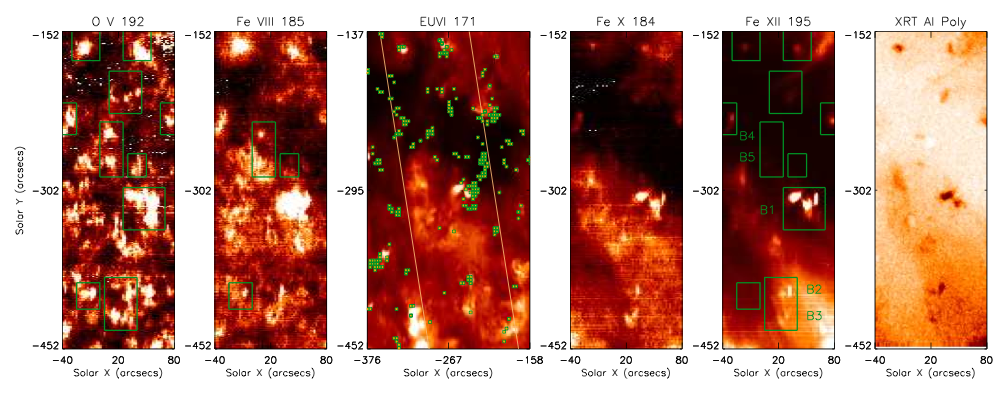Introduction:
Intensive investigation of the solar atmosphere using state-of-the-art ground- and space-based instrumentation shows
that various small scale transient brightenings are omnipresent. It is crucial to establish links between these events as
they can potentially contribute to the transfer of mass and energy in the atmosphere. The aim of the present study is
to identify the true nature of the transient EUV brightenings, called blinkers, or, in other words, to find what causes
the observed transient brightenings. We also investigated whether they have coronal signature, i.e., the link between
EUV and coronal transient features, thereby the contribution of events associated with blinkers to coronal heating.
For detailed description and discussion see Subramanian et. al. (2012).
Observations:
In this study, observations of an isolated equatorial coronal hole (ECH) on 2007 November 12 (approx 10 hours) obtained with SOT, EIS and XRT onboard Hinode, CDS onboard SoHO and EUVI onboard STEREO were used. Coronal holes, because of their low background emission at coronal temperatures when compared to the quiet Sun or active region corona, are ideal to study small scale transient events at coronal temperatures.

Figure 1 - Blinker group 1 (left) and 3 (right), from top in CDS O V 629 A, EUVI 304 A, EUVI 171 A and XRT Al_poly.
Blinkers with and without coronal counterparts:
In the first part of this work, we identified blinkers using an automated identification procedure (see Subramanian et. al., 2010) independently in CDS O V, EUVI 171 A and XRT Al_poly data and were visually grouped into individual events. All CDS O V blinker events showed a counterpart in EUVI 171 A and 304 A images and 57% of them showed counterpart in X-rays. Hence, we classified them into two categories, one with X-ray counterpart (blinker group 1: Figure 1 - left) and other with no X-ray counterpart (blinker group 3: Figure 1 - right).
Although, blinkers were seen in EUVI 171 A and X-ray images, the question of whether they can reach coronal temperatures remained open, due to the significant contribution of transition-region emission to the passbands. This motivated us to investigate blinkers further using spectroscopic data from Hinode/EIS which is currently the best spectrometer for studying coronal features. The above discussed events could not be studied with EIS, as the corresponding CDS data did not have an overlap with the EIS field-of-view. Hence, in the second part of the work, we used only the large raster from EIS (which overlaps with the CDS large raster field of view), along with EUVI 171 A and 304 A, and XRT data series. A set of 12 blinker groups automatically identified in EUVI 171 A, that correspond to the field-of-view and timing of the large EIS raster (Figure 2), were studied with EIS. All of them were clearly observed in the EIS O V 192.90 A and Fe VIII 185.21 A lines. Out of the 12 blinker groups, 8 were found to have an EIS Fe X 184.590 A, Fe XII 195.12 A and X-ray counterpart suggesting that events associated with the blinkers can release thermal energy directly in the solar corona. Out of the remaining 4 events, a sample of 2 events (B4 & B5) are shown in Figure 3. Though they were observed in the EUVI 171 A and X-ray images, they did not reach EIS Fe X 184.59 A temperatures and above (> log T = 6.0 K). Therefore, the appearance of B4 and B5 in the EUVI 171 A and X-ray passband is, therefore, due to the contribution of transition-region emission as discussed earlier.

Figure 2 -EIS rasters of an ECH region from 2007 November 12. From left, EIS
O V 192.90 A and Fe VIII 185.21 A intensity plots, EUVI 171 A image over-plotted
with the brightenings identified as green boxes, EIS Fe X 184.590 A and Fe XII 195.12 A
intensity plots, XRT Al_poly image. Box symbols over-plotted on the O V 629 A and Fe XII 195.12 A
rasters show the 12 EUVI 171 A brightening events, with and without coronal counterparts
at Fe XII temperatures. The boxes over-plotted on the Fe VIII 185.21 A raster mark events
with no coronal counterpart in Fe XII 195.12 A.

FFigure 3 - Brightening events B4 and B5 (Figure 2) with no coronal counterparts
in Fe XII 195.12 A as observed in XRT Al_poly (left) and EUVI 171 A (right) images.
Conclusion:
We found, in general, that blinkers with coronal counterparts (in X-rays and/or in EIS Fe XII 195.12 A) are associated with various coronal events, e.g. EUV/X-ray jets, brightenings in small-scale loops (coronal bright points) or foot-point brightenings of larger loops. Brightening events having no coronal counterparts appear as point-like brightenings in CDS O V and EUVI 171 A images. As they do not reach coronal temperatures (> logT~6.0 K),
they certainly are associated with chromospheric features, e.g.
larger spicules or have transition region origin, e.g. flows
in small scale TR loops. Even these blinkers reach lower coronal heights (upto logT~5.8 K), i.e., Fe VIII 185.21 A as seen in Figure 2. The lifetimes of these
blinkers are different at different wavelengths, i.e. different temperatures, decreasing from the chromosphere
to the corona.
To conclude, we believe now that the term blinker is a catch-all
term for a vast range of transient events of coronal, transition region or chromospheric origin.
References:
S. Subramanian, M. S. Madjarska, J. G. Doyle and D. Bewsher, 'What is the true nature of blinkers?', Astronomy and Astrophysics, Volume 538, id.A50, 2012.


